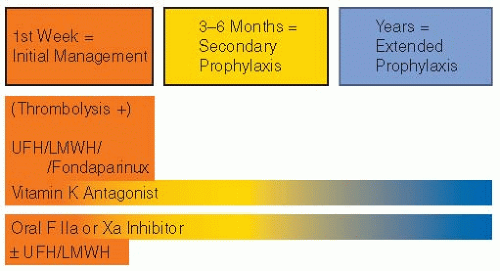Intravenous unfractionated heparin (UFH), which was the initial treatment standard until 10 to 15 years ago, is currently mainly used for special patient groups summarized in
Table 87.2. It is usually recommended to initiate UFH treatment with a bolus dose of 80 IU/kg followed by an infusion of 18 U/kg/h.
1 This UFH regimen is based on three RCTs totaling 292 patients,
which compared this or a similar regimen with fixed initial dosing.
11,12,13 The dose is then adjusted according to the results of an activated partial thromboplastin time (aPTT) performed 4 to 6 hours after initiation of UFH to keep the aPTT in a therapeutic range. aPTT reagents vary in their sensitivities to UFH so that an aPTT range that corresponds to an anti-factor Xa heparin level of 0.3 to 0.7 IU/mL should be targeted.
1 Subcutaneous injection of UFH versus intravenous therapy, both adjusted according to the aPTT, was compared in a meta-analysis of six trials totaling 783 patients
14 and demonstrated favorable results with subcutaneous UFH for recurrent VTE (relative risk [RR], 0.62; 95% CI, 0.39 to 98) and major bleeding (RR, 0.79; 95% CI, 0.42 to 1.48). A subcutaneous, weight-adjusted, unmonitored UFH regimen (250 IU/kg twice-daily dosing after a 333 U/kg initial dose) was compared with LMWH therapy in an RCT (FIDO) of almost 700 patients with DVT or PE.
15 There was no statistically significant difference in the incidence of recurrent VTE (3.8% vs. 3.4%) or major hemorrhage during the first 10 days (1.1% vs. 1.4%) with fixed-dose, unmonitored UFH and LMWH. This is the only UFH regimen that allows for convenient outpatient therapy, which actually was achieved entirely for 72% of the patients in this treatment group in the study.










